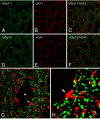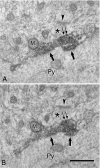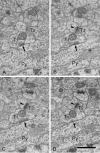Proximity of excitatory and inhibitory axon terminals adjacent to pyramidal cell bodies provides a putative basis for nonsynaptic interactions
- PMID: 19487685
- PMCID: PMC2701041
- DOI: 10.1073/pnas.0900330106
Proximity of excitatory and inhibitory axon terminals adjacent to pyramidal cell bodies provides a putative basis for nonsynaptic interactions
Abstract
Although pyramidal cells are the main excitatory neurons in the cerebral cortex, it has recently been reported that they can evoke inhibitory postsynaptic currents in neighboring pyramidal neurons. These inhibitory effects were proposed to be mediated by putative axo-axonic excitatory synapses between the axon terminals of pyramidal cells and perisomatic inhibitory axon terminals [Ren M, Yoshimura Y, Takada N, Horibe S, Komatsu Y (2007) Science 316:758-761]. However, the existence of this type of axo-axonic synapse was not found using serial section electron microscopy. Instead, we observed that inhibitory axon terminals synapsing on pyramidal cell bodies were frequently apposed by terminals that established excitatory synapses with neighbouring dendrites. We propose that a spillover of glutamate from these excitatory synapses can activate the adjacent inhibitory axo-somatic terminals.
Conflict of interest statement
The authors declare no conflict of interest.
Figures






Similar articles
-
Axo-axonic synapses formed by somatostatin-expressing GABAergic neurons in rat and monkey visual cortex.J Comp Neurol. 2002 Jan 28;443(1):1-14. doi: 10.1002/cne.1425. J Comp Neurol. 2002. PMID: 11793343
-
Precision and variability in postsynaptic target selection of inhibitory cells in the hippocampal CA3 region.Eur J Neurosci. 1993 Dec 1;5(12):1729-51. doi: 10.1111/j.1460-9568.1993.tb00240.x. Eur J Neurosci. 1993. PMID: 8124523
-
Specialized inhibitory synaptic actions between nearby neocortical pyramidal neurons.Science. 2007 May 4;316(5825):758-61. doi: 10.1126/science.1135468. Science. 2007. PMID: 17478724
-
Axo-axonic synapses: Diversity in neural circuit function.J Comp Neurol. 2021 Jun;529(9):2391-2401. doi: 10.1002/cne.25087. Epub 2020 Dec 18. J Comp Neurol. 2021. PMID: 33314077 Free PMC article. Review.
-
Axo-axonic cells in neuropsychiatric disorders: a systematic review.Front Cell Neurosci. 2023 Jun 26;17:1212202. doi: 10.3389/fncel.2023.1212202. eCollection 2023. Front Cell Neurosci. 2023. PMID: 37435048 Free PMC article.
Cited by
-
Adaptation to photoperiod via dynamic neurotransmitter segregation.Nature. 2024 Aug;632(8023):147-156. doi: 10.1038/s41586-024-07692-7. Epub 2024 Jul 17. Nature. 2024. PMID: 39020173
-
Three-dimensional spatial distribution of synapses in the neocortex: a dual-beam electron microscopy study.Cereb Cortex. 2014 Jun;24(6):1579-88. doi: 10.1093/cercor/bht018. Epub 2013 Jan 30. Cereb Cortex. 2014. PMID: 23365213 Free PMC article.
-
Organization of NMDA receptors at extrasynaptic locations.Neuroscience. 2010 Apr 28;167(1):68-87. doi: 10.1016/j.neuroscience.2010.01.022. Epub 2010 Jan 20. Neuroscience. 2010. PMID: 20096331 Free PMC article.
-
Distribution of vesicular glutamate transporter 2 (VGluT2) in the primary visual cortex of the macaque and human.J Comp Neurol. 2013 Jan 1;521(1):130-51. doi: 10.1002/cne.23165. J Comp Neurol. 2013. PMID: 22684983 Free PMC article.
-
From synaptically localized to volume transmission by nitric oxide.J Physiol. 2016 Jan 1;594(1):9-18. doi: 10.1113/JP270297. Epub 2015 Nov 18. J Physiol. 2016. PMID: 26486504 Free PMC article. Review.
References
-
- DeFelipe J, Jones EG. Cajal on the Cerebral Cortex. New York: Oxford Univ Press; 1988.
-
- DeFelipe J, Fariñas I. The pyramidal neuron of the cerebral cortex: Morphological and chemical characteristics of the synaptic inputs. Prog Neurobiol. 1992;39:563–607. - PubMed
-
- Spruston N. Pyramidal neurons: Dendritic structure and synaptic integration. Nat Rev Neurosci. 2008;9:206–221. - PubMed
-
- Ren M, Yoshimura Y, Takada N, Horibe S, Komatsu Y. Specialized inhibitory synaptic actions between nearby neocortical pyramidal neurons. Science. 2007;316:758–761. - PubMed
-
- Ribak CE. Aspinous and sparsely-spinous stellate neurons in the visual cortex of rats contain glutamic acid decarboxylase. J Neurocytol. 1978;7:461–478. - PubMed
Publication types
MeSH terms
LinkOut - more resources
Full Text Sources
Molecular Biology Databases

